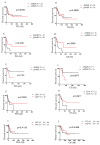Promising Therapeutic Impact of Immune Checkpoint Inhibitors in Type II Endometrial Cancer Patients with Deficient Mismatch Repair Status
- PMID: 37107907
- PMCID: PMC10137870
- DOI: 10.3390/healthcare11081073
Promising Therapeutic Impact of Immune Checkpoint Inhibitors in Type II Endometrial Cancer Patients with Deficient Mismatch Repair Status
Abstract
Type II endometrial cancer (EC) is responsible for most endometrial cancer-related deaths due to its aggressive nature, late-stage detection, and high tolerance to standard therapies. Thus, novel treatment strategies for type II EC are imperative. For patients with mismatch repair-deficient (dMMR) tumors, immunotherapy with immune checkpoint inhibitors represents a promising therapeutic strategy. However, the prevalence of dMMR tumors in type II EC patients remains unclear. In this study, using immunohistochemistry, we evaluated the expression of mismatch repair (MMR) proteins, tumor-infiltrating lymphocytes (CD8+), and immune checkpoint molecules (PD-L1) in 60 patients with type II EC (16, 5, 17, and 22 were endometrioid G3, serous, de-differentiated, and carcinosarcoma cases, respectively) to investigate the therapeutic effect of immune checkpoint inhibitors. Approximately 24 cases (40%) had a loss of MMR protein expression. The positivity rate of CD8+ (p = 0.0072) and PD-L1 (p = 0.0061) expression was significantly associated with the dMMR group. These results suggest immune checkpoint inhibitors (anti-PD-L1/PD-1 antibodies) could effectively treat type II EC with dMMR. The presence of dMMR might be a biomarker for a positive response to PD-1/PD-L1 immunotherapy in type II EC.
Keywords: deficient mismatch repair system; endometrial cancer; immune checkpoint inhibitors; type II.
Conflict of interest statement
The authors declare no conflict of interest.
Figures




Similar articles
-
Endometrial Tumors with MSI-H and dMMR Share a Similar Tumor Immune Microenvironment.Onco Targets Ther. 2021 Aug 16;14:4485-4497. doi: 10.2147/OTT.S324641. eCollection 2021. Onco Targets Ther. 2021. PMID: 34429613 Free PMC article.
-
High density of cytotoxic T-lymphocytes is linked to tumoral PD-L1 expression regardless of the mismatch repair status in colorectal cancer.Acta Oncol. 2021 Sep;60(9):1210-1217. doi: 10.1080/0284186X.2021.1933585. Epub 2021 Jun 5. Acta Oncol. 2021. PMID: 34092167
-
Efficacy and Safety of PD-1/PD-L1 Inhibitor as Single-Agent Immunotherapy in Endometrial Cancer: A Systematic Review and Meta-Analysis.Cancers (Basel). 2023 Aug 9;15(16):4032. doi: 10.3390/cancers15164032. Cancers (Basel). 2023. PMID: 37627060 Free PMC article. Review.
-
Dedifferentiated Endometrial Carcinoma Could be A Target for Immune Checkpoint Inhibitors (Anti PD-1/PD-L1 Antibodies).Int J Mol Sci. 2019 Jul 31;20(15):3744. doi: 10.3390/ijms20153744. Int J Mol Sci. 2019. PMID: 31370215 Free PMC article.
-
Advances in Immunotherapy for Endometrial Cancer: Insights into MMR Status and Tumor Microenvironment.Cancers (Basel). 2024 Nov 22;16(23):3918. doi: 10.3390/cancers16233918. Cancers (Basel). 2024. PMID: 39682106 Free PMC article. Review.
References
-
- World Health Organization . Global Health Estimates 2015: Deaths by Cause, Age, Sex, by Country and by Region, 2000–2015. World Health Organization; Geneva, Switzerland: 2016.
-
- Sung H., Ferlay J., Siegel R.L., Laversanne M., Soerjomataram I., Jemal A., Bray F. Global Cancer Statistics 2020: GLOBOCAN estimates of incidence and mortality worldwide for 36 cancers in 185 countries. CA Cancer J. Clin. 2021;71:209–249. - PubMed
LinkOut - more resources
Full Text Sources
Research Materials

